gastritis
bloating
diarrhea
sour taste in mouth
Helicobacter pylori
What are the consequences of changes in stomach acidity?
The main danger of increasing the secretory function of the stomach is the development of an inflammatory process in the mucous membrane of the organ, followed by its damage and the development of structural defects. A change in the pH of the gastric environment is always accompanied by clinical symptoms, the severity of which depends on the severity of the inflammatory process and the nature of the structural and functional disorders.
Causes of hypoacid gastritis
The reasons due to which this disease appears can be external and internal.
External ones include:
- abuse of tobacco products and alcoholic beverages;
- improper diet, spicy, fried, fatty, smoked foods;
- abuse of medications with side effects on the gastric mucosa;
- harmful effects of chemicals and radioactive substances;
Internal include:
- gastrointestinal pathologies and disorders of the immune system;
- impaired metabolism, liver, pancreas and thyroid glands;
- various genetic abnormalities in the development of the mucous membrane.
Hypoacid gastritis most often affects adults and males. Children and women are less susceptible to this disease.
Symptoms and signs of the disease
The symptoms of such gastritis are associated with the severity of the disease. At the very beginning, they may not be noticeable at all. But later complaints with hypoacid gastritis are as follows:
- pain in the upper abdomen (sometimes radiating under the ribs on the left side);
- feeling of discomfort (feeling of heaviness, bloating);
- belching “rotten eggs”, metallic taste in the mouth, tongue with a gray coating;
- poor appetite;
- frequent diarrhea or constipation;
- nausea, excessive salivation;
- chronic fatigue, headaches, low performance;
- weight loss, changes in sleep patterns.
During a severe exacerbation, other signs may be added: rapid heartbeat, fainting.
How to diagnose hypoacid gastritis
If you notice similar symptoms, you should consult a specialist in the field of gastroenterology for diagnosis. To determine the clinical picture and make a correct and accurate diagnosis, the doctor usually conducts an examination, finds out complaints and prescribes tests and studies, as a result of which the type of pathology and how affected the gastric mucosa is determined. To determine chronic hypoacid gastritis use:
- visual examination of the stomach using a gastroscope (gastroscopy);
- endoscopic biopsy (taking material for biopsy);
- pH-metry of the acidity of secreted gastric juice;
- blood tests and coprogram.
Having collected a complete picture as a result of instrumental and laboratory studies, the doctor proceeds to drawing up a treatment program.
How is stomach acid measured?
From television advertising, everyone knows for sure that acidity needs to be normalized, wherever it is - in the mouth or in the stomach. However, before bringing something back to normal, it is necessary to determine in which direction and how large the deviation is.
Where it should be sour
Without going into details from the general chemistry course, let us remember that the acidity of the medium can be high (acidic medium) or low (alkaline medium). To assess it, the pH value is used: the lower the pH, the higher the acidity. A neutral pH - for example, water - is 7.0.
Throughout the human gastrointestinal tract, various digestive juices are secreted. Depending on the function of a particular area, they must have a certain acidity - otherwise digestion will not be effective. For example, in the mouth the pH level is normally above 7, the environment is alkaline (this is why teeth deteriorate so much due to reflux - the backflow of acidic gastric contents). The same is true in the esophagus. The environment in the stomach is acidic, and at the entrance and exit from it it is less acidic than in the central section. In the small intestine the pH is alkaline, and in the large intestine it is again acidic.
Archived: gastric intubation
Changes in the normal pattern of acidity are characteristic of many diseases, and therefore this indicator has never gone unnoticed by doctors. Previously, gastric intubation was used to determine acidity. A fairly thick tube-probe was inserted into the patient’s stomach for a long time, through which samples of the secreted juice were taken. First, secretion was assessed on an empty stomach, then so-called “test breakfasts” were administered through a probe - cabbage broth, meat broth, caffeine solution. The acidity of the obtained samples was examined “outside” the patient.
The disadvantage of the method was primarily its discomfort for patients. In addition, the result obtained was very general - approximately like “the average temperature in the hospital.” The probe took a mixture of all gastric juices, without taking into account which section and how “sour” the juice secreted.
Fine technique: pH-metry and endoscopy
pH testing began to come into practice in the 1960s. It is also not very pleasant for the patient, but it is still easier to tolerate: the inserted probe is noticeably thinner, and the time it spends inside is shorter. The main achievement in comparison with probing was an increase in accuracy, and here's why: along the entire length of the thin probe there are electrodes that measure acidity. Their position is chosen in such a way that it approximately corresponds to the esophagus, three sections of the stomach and the duodenum. The number of electrodes may vary depending on the purpose of the study.
However, both the height and size of the stomach are different for everyone, and the probes, albeit in several standardized sizes, are designed for the average, “typical” person. Doctors again wanted to increase accuracy, and they combined pH-metry with EGDS (examination using a flexible endoscope). During an endoscopic examination, you can measure acidity exactly in those areas that are of interest, make as many such measurements as you like, and ultimately get a complete “acidity map” of the stomach and its “surroundings.”
All inclusive program
However, sometimes this is not enough. In gastroesophageal reflux disease (GERD), when the contents of the underlying parts of the gastrointestinal tract from time to time enter the overlying ones, a single acidity measurement may not give anything. For such patients, daily pH measurements are used. In the same way, a thin probe with electrodes is inserted, but these electrodes are “able” to record all the collected information on a special device the size of a powder compact.
During the day, the patient with the probe leads his usual lifestyle: eats, works, walks, etc. Everything that happens to him - the emotions he experiences, changes in body position and physical activity, the quantity and quality of what he eats - he writes down in a diary. The doctor then compares these recordings with the information from the probe.
When is acidity tested?
Acidity testing is used in the diagnosis of gastric and duodenal ulcers, various gastritis, and GERD. It can be useful for chronic recurrent cough, which occurs in the absence of diseases of the respiratory system, as well as for pain in the heart area - of course, after a cardiac examination.
By the way, do not be surprised if you are sent for an ECG before performing pH measurements. Inserting a tube into the esophagus can trigger a heart attack, so you need to make sure there is no predisposition.
Be healthy!
Lidiya Kulikova
Photo istockphoto.com
Hypoacid gastritis: treatment
The treatment of such gastritis is based on an integrated approach using various methods and medications acting in different directions.
- To return the functioning of the digestive system to normal, replacement therapy is used (preparations of natural gastric juice, hydrochloric acid, enzymes).
- Antispasmodics are used to relieve pain.
- If, based on research results, Helicobacter pylori was detected in the body, then antibiotics are prescribed.
- Impaired metabolism during gastritis leads to a lack of nutrients, so vitamin complexes containing B vitamins and folic acid are prescribed.
- Probiotics are used to restore intestinal flora.
Medicines for hypoacid gastritis should be used strictly as prescribed by the doctor, since deviation from the regimen may disrupt the course of treatment. An important factor during treatment is diet. In this case, the patient is assigned to table No. 2, where rough and indigestible food, very hot and cold dishes are excluded from the diet. In addition, if the secretion of hydrochloric acid decreases, milk consumption should be reduced, replacing it with fermented milk products. Portions should be small, but 6 times a day. As an auxiliary treatment, traditional medicine is possible, which is also best agreed upon with the treating specialist. The most commonly used are decoctions of rose hips, blueberries, and mixtures of aloe and honey.
Products for a diet with low acidity
Some foods in a diet with low acidity are completely opposite to those with high acidity. Others largely coincide with the menu for hyperacid gastritis. Let's get into the details:
- bread - it should be present in the diet, but stale or slightly dried; It is not at all necessary to refuse rye bread, unless there are manifestations of flatulence; You will still have to give up baked goods, as well as fried pies or fatty crumpets;
- cereals - buckwheat, oatmeal, rice and other cereals are recommended, with the exception of pearl barley;
- meat and fish - the presence of lean varieties of both meat and fish in the diet is welcome; these are lean parts of beef, chicken, turkey, as well as pollock or cod, but not salmon or halibut;
- vegetables - cabbage, zucchini, pumpkin, carrots, potatoes, ripe tomatoes, greens (except onions), cucumbers, beans are allowed; turnips, baked and with vegetable oil, are regarded as a folk remedy that significantly facilitates the functioning of the gastrointestinal tract; hard-to-digest vegetables (cabbage, legumes) should not be consumed during periods of exacerbation;
- fruits and berries are allowed, but in moderation, citrus fruits, as well as apricots, fleshy grapes, strawberries, raspberries, wild strawberries, black currants, gooseberries;
- Among dairy products, it is better to give preference to low-fat cottage cheese, milk, good hard cheese, kefir and natural yoghurts; fatty dairy products, including butter, may be present in the diet, but in very small quantities and rarely;
- As for drinks, juices or fruit drinks made from sea buckthorn, lingonberries, cranberries, and rose hips are recommended; occasionally kvass and coffee are allowed; It is better to avoid strong tea and alcohol-containing drinks;
- The use of broths - vegetable, meat, fish - is encouraged; outside periods of exacerbation of gastritis, a portion of meat/vegetables along with such broths, that is, full-fledged soups, is also allowed
Popular questions about hypoacid gastritis
How to determine low stomach acidity?
Only pH-metry can give an accurate determination of acidity. But you can suspect its low level if you can safely eat sour lemon.
How to distinguish gastritis with high and low acidity?
There are certain signs that characterize different types of acidity. If it is heartburn or sour belching, then most likely this indicates increased acidity. Low blood pressure is characterized by belching with the smell of rotten eggs, which indicates poorly digested food.
What should you not eat if you have gastritis with low acidity?
If such gastritis is detected, it is better to forget about smoked, fatty, spicy foods, fermented cheeses, chocolate, coffee and carbonated drinks.
general information
In 80% of cases, the cause of the development of the inflammatory process with high acidity of the stomach is the microorganism Helicobacter pylori, which disrupts the natural protective properties of the stomach and leads to damage to the epithelium of the organ. Gastritis with high acidity can develop in people regardless of age, including children.
Other factors predisposing to the development of this condition include:
- Regular exposure to stress on the body.
- Poor nutrition, predominance of fried and fatty foods in the diet, as well as deep-fried dishes.
- Abuse of so-called snacks.
- Long-term or uncontrolled use of drugs from the group of non-steroidal anti-inflammatory drugs. Frequently eating food that is too hot or too cold. In addition, people with thyroid diseases, diabetes mellitus and gout have a high predisposition to the development of hyperacid gastritis.
Why is high acidity dangerous?
Gastric juice contains hydrochloric acid, which is necessary to break down food components. To prevent the acidic environment from damaging the walls of the stomach, protective mucus is produced. With increased acidity of the stomach, destruction of the mucous protective layer is observed, followed by the formation of an inflammatory process, the formation of erosions and ulcers.
Clinical symptoms
Inflammatory damage to the organ with increased secretion of gastric juice often worsens during the off-season, in the autumn or spring months. Symptoms of high stomach acidity include:
- Drawing or cramping pain in the epigastric region, which often intensifies after eating. In the acute course of the inflammatory process, the pain may be accompanied by vomiting, which brings temporary relief.
- Heartburn, which is caused by acidic stomach contents refluxing into the esophagus.
- Belching sour.
- Bad breath.
- Stool disorders such as constipation or diarrhea.
Other symptoms of increased stomach acidity during gastritis include weakness, dizziness, increased sweating, excessive gas formation in the intestines (flatulence), increased salivation, increased or decreased appetite, and the appearance of a white or gray coating on the surface of the tongue. Reduced stomach acidity is accompanied by symptoms such as decreased appetite, a feeling of heaviness in the epigastrium, and rotten belching.








